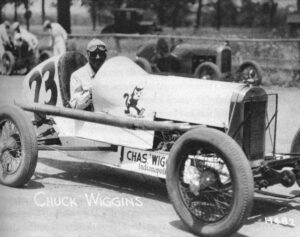 Willy T. Ribbs is rightly credited with breaking barriers as the first Black driver to qualify for the Indy 500, but another driver likely would have broken that barrier sooner – possibly more than 60 years sooner – if not for Jim Crow.
Willy T. Ribbs is rightly credited with breaking barriers as the first Black driver to qualify for the Indy 500, but another driver likely would have broken that barrier sooner – possibly more than 60 years sooner – if not for Jim Crow.
A native Hoosier, Charles “Charlie” Wiggins not only was one of the fastest drivers of his day (in 1927 he fell about a second short of setting a new world record on a one-mile dirt track), he also was a respected race car mechanic.
Moving to Indianapolis from Evansville after World War I, Wiggins opened a garage and quickly set about building his own race car from spare parts. Dubbed “The Wiggins Special,” the car earned Wiggins numerous checkered flags and the nickname “The Negro Speed King.”
What it couldn’t earn him was a spot in the Indianapolis 500 or other events sanctioned by the American Automobile Association, because the AAA allowed only white drivers and crews. To give Black racers opportunities to compete, in 1924 a consortium of five Black and two white businessmen created the Colored Speedway Association (often described as racing’s equivalent to Negro League Baseball).
The centerpiece of the new racing association was the 100-mile Gold and Glory Sweepstakes. Held on the one-mile dirt track at the Indiana State Fairgrounds, the Gold and Glory was for a dozen years one of the premier events for Black drivers, and Wiggins won it four times. The Gold and Glory series came to an end after a horrible 13-car crash in 1936. Among those caught up in the melee was Wiggins, who lost his right leg and right eye.
By that time, Wiggins had already established himself as a deft mechanic. In fact, in 1934, he did get to work on an Indy 500 race car – albeit secretly. Hired surreptitiously by driver Bill Cummings to fine tune his car, Wiggins masqueraded as a janitor, pushing a broom by day and working on the car at night. The result? Cummings won the race … a finish Wiggins had to watch from the “Coloreds Only” section in the grandstand.
Before his death in 1979, Wiggins used his garage not only to fine tune cars but also to train young mechanics. In 1973 – nearly two decades before Ribbs would qualify for the 500 – he got to see one of those trainees break a barrier he could not by becoming the first African-American mechanic at Indy: Sumner “Red” Oliver earned a spot on the Patrick Racing Team. And the best part? As Road and Track magazine noted in a 2016 article: “no broom required.”
